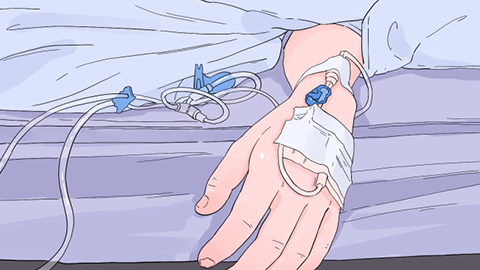What to do if the blood vessel becomes hardened after intravenous infusion
Generally, after intravenous infusion, the hardening of blood vessels may be caused by prolonged infusion time, repeated irritation at the puncture site, medication irritation to the blood vessel, superficial phlebitis, venous thrombosis, and other factors. Patients can visit a正规 hospital to choose general treatment, physical therapy, medication therapy, and other methods to improve the condition. The detailed analysis is as follows:
1. Prolonged Infusion Time
Extended intravenous infusion can cause continuous impact on the vessel from the fluid, increasing pressure on the vessel wall, reducing its elasticity, and eventually leading to hardening. During infusion, appropriately move the limbs not receiving the infusion to promote blood circulation. After the infusion, apply a warm compress to the puncture site and surrounding area using a warm towel for 15–20 minutes, 2–3 times daily, to relieve vascular tension.
2. Repeated Stimulation at the Puncture Site
M ultiple punctures on the same blood vessel can damage the vascular endothelium, leading to fibrous tissue proliferation during vessel wall repair, which causes the vessel to harden. Try to avoid repeated punctures on the same vessel. After infusion, keep the puncture site clean and dry, and avoid friction. If there is slight local discomfort, gently massage the surrounding skin to promote recovery.

3. Medication Irritation to the Vessel
Administration of high-concentration, high-osmolarity medications may irritate the vessel wall, triggering vasoconstriction and inflammatory reactions, which can cause vessel hardening and may be accompanied by mild pain. If local discomfort occurs during infusion, promptly inform the medical staff. Under a doctor's guidance, apply topical medications such as mucopolysaccharide polysulfate cream to the hardened vessel area, and simultaneously use magnesium sulfate solution for wet compresses to alleviate irritation.
4. Superficial Phlebitis
During infusion, the vessel may suffer from drug-induced or puncture-related injury, leading to superficial venous inflammation. Symptoms may include vessel wall congestion, swelling, hardening, redness, and pain. Under a doctor's guidance, treat with medications such as diclofenac sodium gel, cefaclor dry suspension, and horse chestnut extract tablets (Venarus). Avoid pressing on the affected area and reduce physical activity during treatment.
5. Venous Thrombosis
After vascular endothelial injury, blood may easily coagulate locally to form a thrombus, leading to vascular occlusion and hardening, possibly accompanied by localized swelling. Promptly visit a hospital for examination and, under a doctor's guidance, treat with medications such as low molecular weight heparin sodium injection, warfarin sodium tablets, and rivaroxaban tablets. Avoid strenuous activity during treatment to prevent thrombus dislodgement.
In daily life, avoid getting the puncture site wet too soon after infusion; maintain a light diet and drink plenty of water. If vessel hardening persists or worsens, seek medical attention promptly.







